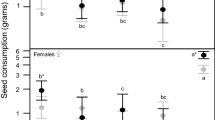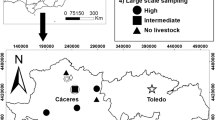Abstract
Blue jays consume large quantities of acorns to fuel energy-demanding caching flights in the fall. Yet blue jays possess no known physiological adaptation to counter the negative effects of a high tannin diet on protein digestion. Dietary experiments were conducted to determine if blue jays could subsist on an acorn-only diet, and if they could not, to determine whether supplements of acorn weevil larvae (Curculio), present inside acorns, enabled them to maintain their mass. Comparative tannin assays also were conducted on Lepidobalanus (low tannin; white oak) and Erythrobalanus (high tannin; pin oak) acorns using radial diffusion assay. Captive jays consumed considerable acorn material, yet were unable to maintain mass on ad lib. acorn-only diets or on an acorn +1.5 g larvae/day supplement. There were no significant differences in mass loss between high and low tannin diets. In contrast, blue jays were able to stabilize mass on a diet of acorns +5.0 g larvae supplement/day. These results suggest that acorn weevil larvae, or perhaps other insects, counteract the effects of acorn tannins in the jay diet allowing jays to subsist largely on acorns during the fall caching season. Oak demographic processes may be partly regulated by a tri-trophic relationship among plant, insect and bird. Acorn weevil larvae, considered damaging to oak populations, may actually facilitate oak recruitment and population vagility in the long-term.
Similar content being viewed by others
References
Beal FEL (1896) The blue jay and its food. In: Yearbook of the Department of Agriculture. Government Printing Office, Washington, pp 197–206
Berenbaum M (1980) Adaptive significance of midgut pH in larval Lepidoptera. Am Nat 115:138–146
Bernays EA, Driver GC, Bilgener M (1989) Herbivores and plant tannins. Adv Ecol Res 19:263–302
Blau PA, Feeny P, Contardo L, Robson DS (1978) Allylglucosinolate and herbivorous caterpillars: a contrast in toxicity and tolerance. Science 200:1296–1298
Briggs JM, Smith KG (1989) Influence of habitat on acorn selection by Peromyscus leucopus. J Mamm 70:35–43
Brower LP (1969) Ecological chemistry. Sci Am 220:22–29
Bryant JP, Kuropat PJ (1980) Selection of winter forage by subarctic browsing vertebrates: the role of plant chemistry. Annual Rev Ecol Syst 11:261–285
Butler LG, Rogler JC, Mehansho H, Carlson DM (1986) Plant flavonoids in biology and medicine. In: Cody V, Middleton E Jr, Harborne JB (eds) Progress in clinical and biological research vol 213, Alan R. Liss, New York, pp 141–157
Darley-Hill S, Johnson WC (1981) Acorn dispersal by the blue jay (Cyanocitta cristata L.). Oecologia 50:231–232
Davis MB (1981) Quaternary history and the stability of deciduous forests. In: West DC, Shugart HH, Botkin DB (eds) Forest succession. Springer, New York, pp 132–177
Davis MB (1987) Invasions of forest communities during the Holocene: beech and hemlock in the Great Lakes region. In: Gray AJ, Crawley MJ, Edwards PJ (eds) Colonization, succession and stability. Blackwell Scientific Publications, Cambridge, Massachusetts, pp 373–393
Davis MB, Zabinski C (1992) Changes in geographical range resulting from greenhouse warming-effects on biodiversity of forests. In: Peters RL, Lovejoy TE (eds) Global warming and biological diversity. Yale University Press, New Haven, Connecticut
Gibson LP (1982) Insects that damage northern red oak acorns. United States Department of Agriculture-Forest Service, Northeastern Forest Experiment Station. Research paper NE-492
Goldstein JL, Swain T (1965) The inhibition of enzymes by tannins. Phytochemistry 4:185–192
Hagerman AE (1987) Radial diffusion method for determining tannin in plant extracts. J Chem Ecol 13:437–449
Hagerman AE (1988) Extraction of tannin from fresh and preserved leaves. J Chem Ecol 14:453–461
Hagerman AE, Robbins CT (1987) Implications of soluble tannin-protein complexes for tannin analysis and plant defense mechanisms. J Chem Ecol 13:1243–1259
Izhaki I, Safriel UN (1989) Why are there so few exclusively frugivorous birds? Experiments in fruit digestibility. Oikos 54:23–32
Johnson WC, Adkisson CS (1985) Dispersal of beechnuts by blue jays in fragmented landscapes. Am Midl Nat 113:319–324
Johnson WC, Webb T III (1989) The role of blue jays (Cyanocitta cristata L.) in the postglacial dispersal of fagaceous trees in eastern North America. J Biogeog 16:561–571
Johnson WC, Sharpe DM, DeAngelis DL, Fields DE, Olson RJ (1981) Modeling seed dispersal and forest patch dynamics. In: Sharpe DM, Burgess RL (eds) Forest island dynamics in mandominated landscapes. Springer, New York, pp 215–239
Koenig WD, Heck MK (1988) Ability of two species of oak woodland birds to subsist on acorns. Condor 90:705–708
Ligon JD, Martin DJ (1974) Pinon seed assessment by the pinon jay. Anim Behav 22:421–429
Lotti T (1959) Selecting sound acorns for planting bottomland hardwood sites. J For 57:923
Martin JS, Martin MM (1983) Tannin assays in ecological studies-precipitation of ribulose-1,5-bisphosphate carboxylase/oxygenase by tannic acid, Quebracho, and oak foliage extracts. J Chem Ecol 9:285–294
Martin MM, Martin JS (1984) Surfactants: their role in preventing the precipitation of proteins by tannins in insect guts. Oecologia 61:342–345
Ofcarcik RP, Burns EE (1971) Chemical and physical properties of selected acorns. J Food Sci 36:576–578
Robbins CT, Hanley TA, Hagerman AE, Hjeljord O, Baker DL, Schwartz CC, Mautz WW (1987) Role of tannins in defending plants against ruminants: reduction in protein availability. Ecology 68:98–107
Scarlett TL, Smith KG (1991) Acorn preference of urban blue jays (Cyanocitta cristata) during fall and spring in northwestern Arkansas. Condor 93:438–442
Schopmeyer CS (1974) Seeds of woody plants in the United States. (Agriculture Handbook no 450) USDA-Forest Service, Washington
Short HL (1976) Composition and squirrel use of acorns of black and white oak groups. J Wild Manage 40:479–483
Smallwood PD, Peters WD (1986) Grey squirrel food preferences: the effects of tannin and fat concentration. Ecology 67:168–174
Soule ME, Wilcox BA (1980) Conservation biology. Sinauer Associates, Sunderland, Massachusetts
Swain T (1979) Tannins and lignins. In: Rosenthal GA, Janzen DH (eds) Herbivores: their interaction with secondary plant metabolites. Academic Press, New York, pp 657–682
Valburg LK (1992) Eating infested fruits: interactions in a plant-disperser-pest triad. Oikos 65:25–28
VanderWall SB (1990) Food hoarding in animals. The University of Chicago Press, Chicago
Weckerly FW, Derrick WS, Semlitsch RD (1989) Germination success of acorns (Quercus): insect predation and tannins. Can J For Res 19:811–815
Williams CE (1989a) Acorn insects. (Entomology notes no 20). Michigan Entomological Society, Michigan State University, East Lansing
Williams CE (1989b) Checklist of North American nut-infesting insects and host plants. J Entomol Sci 24:550–562
Author information
Authors and Affiliations
Rights and permissions
About this article
Cite this article
Johnson, W.C., Thomas, L. & Adkisson, C.S. Dietary circumvention of acorn tannins by blue jays. Oecologia 94, 159–164 (1993). https://doi.org/10.1007/BF00341312
Received:
Accepted:
Issue Date:
DOI: https://doi.org/10.1007/BF00341312




